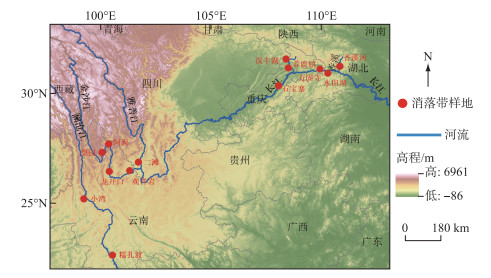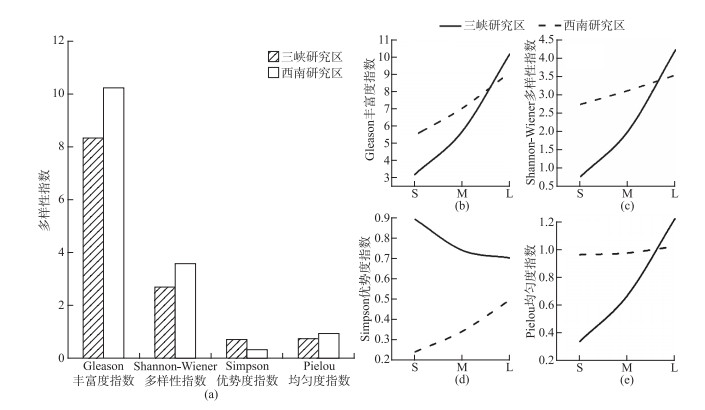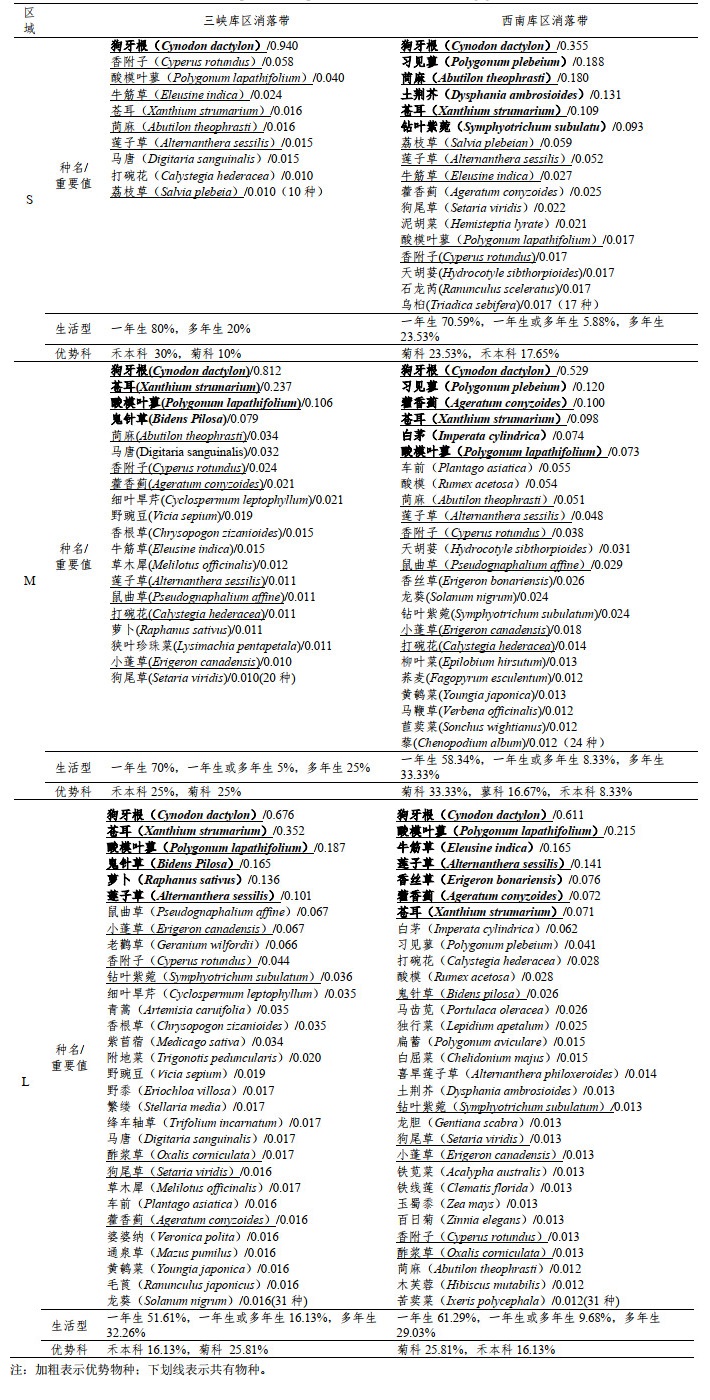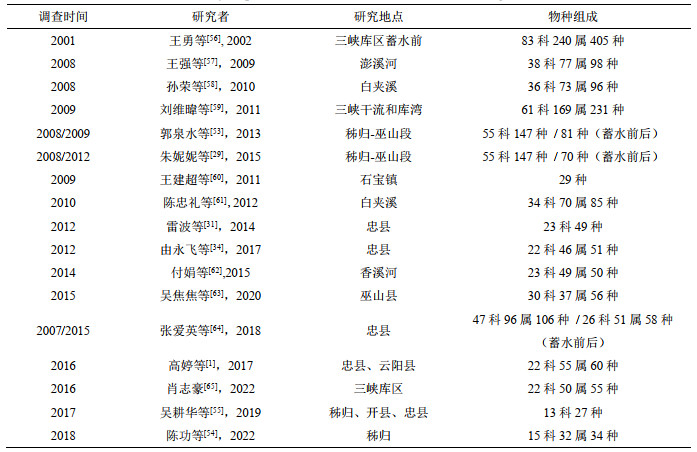水库消落带是指在水库运行中,由于人为水位调度而使库岸周边土地在最高水位与最低水位之间呈现季节性淹没和出露的干湿交替过渡区域。水库消落带相对于自然河岸带往往水位落差更大,如我国三峡库区消落带落差30 m[1],溪洛渡库区消落带落差40 m[2],四川瀑布沟水库消落带落差60 m[3],小湾库区消落带落差60 m[4],因而水库消落带受到干湿交替的变化冲击更为剧烈。水库消落带存在的一系列生态环境问题包括库岸污染带形成、库岸失稳、植物多样性受损以及生态系统脆弱化等问题引起了越来越多的关注[5]。也有学者[6]提出水库消落带作为生态试验场的观点,认为水库运行将为生态学家开展生物多样性及群落演变的动力学过程及其对干扰的响应提供试验场。因而,人们对于消落带这类特殊的生态系统开展了大量的研究和生态修复实践[7-10]。其中以三峡库区消落带为代表,从三峡建设论证至今已有20多年时间,三峡消落带研究从蓄水前预测到蓄水后的实证研究超过千例,基本形成了植物群落[11-13]和土壤环境[14-16]两个持续的关注热点。植物作为消落带重要的组成部分,围绕植物恢复和适生植物筛选,从现存物种组成、群落多样性、植被分布格局、土壤种子库、植物生理生态以及植物修复试验等方面开展了大量研究,取得了一系列研究和实践成果[17-21]。但总的来看,现有的研究大量集中在单级水库消落带,而对于梯级水库消落带相关的研究较少。
我国西南流域规划建设有多座世界级的梯级高坝大库工程[22],随之形成的水库消落带同样面临着植物恢复问题,能否借鉴三峡库区消落带等已有的生态修复研究成果和经验,尚缺乏科学依据。目前有关西南库区消落带植物相关的研究不多,而与三峡库区消落带的比较研究尚未见报道。不同水库消落带自然恢复现状、物种组成和群落多样性有何异同,回答这些问题能够帮助进一步了解水库消落带生态系统的多样性维持机制以及群落构建策略。
生物多样性为了解植物区系的组成、变化和起源起到了重要的作用[23]。葛学军[24]发现并非每个物种在进化上都具有独立性,它们之间存在着系统发育关系。Faith[25]提出了以系统发育进化树上物种之间的枝长表征系统发育多样性,使得整合物种进化历史对生物多样性进行全面深入的评估成为可能。系统发育多样性是描述群落构建过程的重要指标[26],然而目前尚且没有关于三峡或西南库区消落带植物系统发育多样性的研究。研究者们虽然针对三峡库区消落带物种多样性开展了大量研究[27-29],但是,这些研究鲜有涉及系统发育多样性。此外,已有研究[30]显示,消落带植物表现出明显的淹水梯度特征,因此研究者们[31]通常按照高程范围进行分段采样分析。但是,不同水库消落带的水位落差和高程范围差异显著,按高程范围分段表示淹水梯度的方法无法对不同水库进行统一比较,按淹水深度同样也无法适用。
对此,本文为了便于对比分析,统一按照淹水时间划分淹水梯度,为不同水库消落带提供统一的分区采样方法,开展了2021年出露期三峡库区与西南库区消落带现存植物调查,定量比较了二者沿各淹水梯度段的物种组成、物种多样性和系统发育多样性,探讨了水库消落带物种组成的驱动因子、群落构建策略以及多样性的维持机制,从而为不同水库消落带生态修复的相互借鉴提供科学依据。
1 方法 1.1 研究区概况三峡库区位于我国长江中下游,东起湖北宜昌三斗坪,西至重庆江津,库容达383亿m3,总面积1084 km2。通常1—2月水库水位开始从最高水位175 m逐渐消落,汛前消落到死水位145 m,汛期水位在150 m上下波动,9—10月水位迅速上涨到最高水位附近,11—12月水库完全蓄水,表现出“冬水夏陆”的反季节水文情势。从重庆忠县至宜昌市秭归县共选取6个样地,分别位于忠县石宝寨(30°25′N,108°11′E)、开县汉丰湖(31°08′N, 108°32′E)、云阳县养鹿镇(31°05′N, 108°33′E)、秭归县水田坝(31°03′N,110°40′E)、秭归县万固寺(31°00′N, 110°45′E)和秭归县香溪河(30°57′N,110°54′E),如图 1所示,整段地处亚热带季风湿润气候区,四季分明夏季炎热,4—10月平均气温在22℃以上,7—8月平均气温在28℃以上。降雨充沛但季节分配不均,年均降雨量为990~1200 mm, 其中4—10月的降雨量约占全年降雨量的80%。土壤类型以黄壤和黄棕壤为主。建库前消落带土地利用类型以耕地、林草地和河漫滩地为主。

|
图 1 研究区位置 Fig.1 Location of study area |
西南流域包括金沙江、雅砻江和澜沧江等著名水系,蕴藏水能丰富,是我国梯级高坝大库最密集区域。沿金沙江、雅砻江和澜沧江各梯级水库消落带共设置7个观测样地(图 1),分别为梨园水库消落带样地(27°18′N, 100°14′E)、阿海水库消落带样地(27°36′N, 100°26′E)、龙开口水库消落带样地(26°34′N, 100°24′E)、观音岩水库消落带样地(26°26′N, 101°28′E)、二滩水库消落带样地(26°48′N, 101°43′E)、糯扎渡水库消落带样地(23°32′N, 100°10′E)和小湾水库消落带样地(25°17′N,99°21′E)。其中,糯扎渡样地位于暖湿河谷区域,其余各样地均位于典型的干旱河谷区域。与三峡库区一样,各水库均采用“蓄清排浑”的水位调度方式,呈现出“冬水夏陆”的反季节水文情势,水文节律与三峡基本相似。土壤类型以燥红土为主,还有褐红壤、赤红壤、砖红壤、赤红壤土和紫色土等。糯扎渡研究区原生植被以落叶季雨林和竹林为主[32],其余研究区原生植被总体为稀疏灌草丛,其间散生灌木和乔木[33]。
1.2 野外数据采集通常消落带野外调查按照高程梯度进行统一分区采样,例如,以往研究[34-35]将三峡库区消落带划分为145~155、155~165和165~175 m的3个高程段进行采样分析。然而,西南流域各梯级水库消落带水位落差及其高程范围各不相同,与三峡库区消落带也不一致,无法沿用按高程统一划分的分区方法。因此,为了便于对比分析,通过统计各水库的历史水位数据来计算消落带不同高程的平均淹水时间,统一按照淹水时间划分为重度淹水区(S,淹水时间7个月及以上)、中度淹水区(M,淹水时间为5~6个月)和轻度淹水区(L,淹水时间4个月及以下)。
2021年5月底,在三峡库区各样地分别沿S、M、L淹水梯度进行样方设置,样方大小为1 m×1 m,记录样方内植物名称、株数、高度和物种盖度等信息。2021年6月下旬,在西南库区各样地同样分别沿S、M、L淹水梯度进行样方调查。
1.3 数据处理根据样方调查结果,统计各样地分别在S、M、L淹水梯度段的植物物种组成、生活型、个体数、频度和分盖度等,并计算物种重要值Pi,即:
| $ P_i=\left(D_r+F_r+P_r\right) / 3 $ | (1) |
式中,相对多度Dr:(某一物种在样方中的多度/所有物种多度总和)×100%;相对频度Fr:(某一物种在样方中出现的频度/所有物种频度总和)×100%;相对盖度Pr:(某一物种在样方中的盖度/所有物种盖度总和)×100%。
选取Gleason丰富度指数(R)、Shannon-Wiener多样性指数(H′)、Simpson优势度指数(D)和Pielou均匀度指数(E)分析群落物种多样性,公式分别为:
| $ R=S / \ln A $ | (2) |
| $ H^{\prime}=-\sum\limits_{i=1}^s P_i \ln P_i $ | (3) |
| $ D=\sum\limits_{i=1}^s P_i^2 $ | (4) |
| $ E=H^{\prime} / \ln S $ | (5) |
式中,S为物种总数,A为样方数,Pi为物种i的相对重要值。数据的统计分析采用SPSS 26.0软件,用单因素方差分析(ANOVA)法对同一时期不同高程群落指数进行统计检验。
选取Jaccard群落相似性系数(CJ)和Sorensen群落相似性系数(CS)分析群落物种的相似性。
| $ C_{\mathrm{J}}=j /(a+b-j) $ | (6) |
| $ C_{\mathrm{s}}=2 j /(a+b) $ | (7) |
式中,j为两个群落共有物种数,a, b分别为两个群落的物种数。
采用PD群落系统发育多样性指数(PD)、NRI净相关指数、NTI最近邻体指数分析系统发育多样性,公式分别为:
| $ P D=\sum L_{\mathrm{b}} $ | (8) |
| $ N R I=-\frac{M P D_{\mathrm{s}}-M P D_{\mathrm{mds}}}{S D\left(M P D_{\mathrm{mds}}\right)} $ | (9) |
| $ N T I=-\frac{M N T D_{\mathrm{s}}-M N T D_{\mathrm{mds}}}{S D\left(M P D_{\mathrm{mds}}\right)} $ | (10) |
式中, Lb表示连接谱系树上物种的分支长度,SD为标准差,MPD和MNTD分别表示样方中所有物种对的平均谱系距离与平均最近种间谱系距离,MPDs和MNTDs为实际观察值,MPDmds和MNTDmds表示通过软件从物种库中随机抽取999次后获得的平均值。
2 结果 2.1 三峡库区与西南库区消落带物种组成根据调查,三峡库区消落带共发现维管束植物20科36属36种,其中,菊科植物种类最多,其次是禾本科和豆科,分别占比为22.22%、16.67%、11.11%;一年生植物21种,占比58.33%;主要优势物种为狗牙根(Cynodon dactylon)、苍耳(Xanthium strumarium)、酸模叶蓼(Polygonum lapathifolium)和鬼针草(Bidens pilosa)4种。西南库区消落带共发现维管束植物21科41属45种,其中,菊科植物种类最多,其次是禾本科和蓼科,分别占比为26.67%、11.11%、11.11%;一年生植物26种,占比57.78%;主要优势物种为狗牙根、苍耳、苘麻(Abutilon theophrasti)、酸模叶蓼、习见蓼(Polygonum plebeium)、莲子草(Alternanthera sessilis)和藿香蓟(Ageratum conyzoides)7种。
从整体来看,三峡库区消落带与西南库区消落带Jaccard群落相似性系数为30.65%,Sorensen群落相似性系数为46.91%,共有植物19种,分别为苍耳、车前(Plantago asiatica)、打碗花(Calystegia hederacea)、狗尾草(Setaria viridis)、狗牙根、鬼针草、黄鹌菜(Youngia japonica)、藿香蓟、荔枝草(Salvia plebeia)、莲子草、龙葵(Solanum nigrum)、牛筋草(Eleusine indica)、苘麻、鼠曲草(Pseudognaphalium affine)、酸模叶蓼、香附子(Cyperus rotundus)、小蓬草(Erigeron canadensis)、钻叶紫菀(Symphyotrichum subulatum)和酢浆草(Oxalis corniculata),占三峡库区物种数量的52.78%,占西南库区物种数量的42.22%。二者物种分属最多的科均为菊科和禾本科,一年生草本为其主要生活型,狗牙根、苍耳、酸模叶蓼和莲子草为共同的优势物种。
从各淹水梯度段来看(附表Ⅰ),三峡库区消落带与西南库区消落带物种组成均表现为:随着淹水程度的减轻,物种数量逐渐增加;菊科占比逐渐增加,一年生植物占比呈下降趋势,而多年生植物占比呈上升趋势。值得注意的是,二者共有物种数量随淹水程度的减轻逐渐增加,但是其占比却逐渐降低,由附表Ⅰ可见,在消落带S、M、L段,共有物种分别为8、10、11种,占三峡库区比例分别为80.00%、50.00%、35.48%, 占西南库区比例分别为47.06%、41.67%、35.48%,S、M、L段,Jaccard群落相似性系数分别为42.11%、29.41%、21.57%,Sorensen群落相似性系数分别为59.26%、45.45%、35.48%。这意味着二者物种组成的差别随着淹水程度的减轻而增大。然而,从优势物种来看,在M段和L段二者差别较小,M段共有优势物种为狗牙根、苍耳、酸模叶蓼,L段共有优势物种为狗牙根、苍耳、酸模叶蓼、莲子草;在S段,共有优势物种仅有狗牙根,三峡消落带研究区S段以狗牙根占绝对优势,相对来说,西南消落带研究区S段优势物种更为丰富。此外,虽然三峡库区和西南库区物种组成均以菊科和禾本科为主,但是前者在S段主要为禾本科,并随淹水程度的减轻逐渐向菊科过渡,而后者在各淹水梯度段始终以菊科占比最大。
2.2 三峡库区与西南库区消落带群落多样性 2.2.1 物种多样性计算结果三峡库区与西南库区消落带物种多样性指数如图 2a所示,对比可见,西南库区Gleason丰富度指数、Shannon-Wiener多样性指数和Pielou均匀度指数均明显高于三峡库区,表明西南库区消落带物种类型更为丰富,群落构成更为复杂,物种分布更为均匀。同时,三峡库区Simpson优势度明显高于西南库区,优势物种具有较高的优势度。

|
图 2 消落带物种多样性指数对比:(a)整体对比;(b)~(e)沿淹水梯度分段对比 Fig.2 Comparison of species diversity index in the WLFZ: (a) overall comparison; (b)-(e) sectional comparison along flooding gradient |
根据S、M、L三段淹水梯度的多样性对比(图 2b~e),三峡库区和西南库区消落带的Gleason丰富度指数、Shannon-Wiener多样性指数和Pielou均匀度指数均表现为随淹水程度的减轻而逐渐增大。但是,二者的Simpson优势度指数却随淹水梯度表现出明显相反的变化,随着淹水程度的减弱,三峡库区消落带的优势物种的优势度逐渐下降,群落构成更加复杂,而西南库区消落带的优势度不断提高,优势物种更加集中。此外,在S段、M段,三峡库区物种的Gleason丰富度指数、Shannon-Wiener多样性指数和Pielou均匀度指数都明显低于西南库区,但淹水程度较轻的L段数值明显高于西南库区,说明在淹水较严重的S段和M段,西南库区物种多样性更优,而在L段,三峡库区物种多样性更佳。
结合表 1,三峡库区消落带植物群落间的Gleason丰富度指数、Shannon-Wiener多样性指数、Pielou均匀度指数沿淹水梯度的差异较西南库区消落带更为显著,表明三峡消落带在各梯度植物群落的组成结构上发生了更大的变化,即三峡库区物种多样性随淹水梯度变化幅度更大。
| 表 1 沿淹水梯度的植物群落多样性方差分析 Tab. 1 Analysis of variance of plant community diversity along flooding gradient |
三峡库区与西南库区消落带群落系统发育多样性计算结果如图 3所示,在整体水平上,PD系统发育多样性指数均为384左右,二者在系统发育层面没有显著区别。然而与其它水库消落带群落以及森林群落相比,如乌江梯级水库河岸带PD群落系统发育多样性指数接近1000[36],戴云山森林PD群落系统发育多样性指数范围为1270~3091[37],三峡库区与西南库区消落带的PD值明显偏低,说明群落系统发育水平较低。从各淹水梯度来看,三峡库区与西南库区消落带群落系统发育多样性指数PD表现为,L段>M段>S段,三峡库区S段系统发育结构明显低于西南库区,随淹水程度减弱,二者差距逐渐缩小,L段已明显高于后者的系统发育水平,表明三峡库区消落带的系统发育多样性增长幅度更大。

|
图 3 消落带系统发育多样性对比:(a)PD指数;(b)亲缘关系指数 Fig.3 Comparison of phylogenetic diversity of WLFZ: (a) PD index; (b) genetic relationship index |
由图 3可见,三峡库区消落带整体水平上和各个淹水梯度段均显示,NRI<0,NTI<0,表明消落带的植被系统发育结构发散,群落主要由远缘种组成。西南库区S段和M段NRI指数和NTI指数也均小于0,说明系统发育结构发散,群落主要由亲缘关系较远的物种组成。但是,西南库区L段NRI指数<0,表现为系统发育发散,NTI指数>0,表现为系统发育聚集,两个指数得到了相反的结果,可能是因为两种系统发育指数的侧重点不同,NRI侧重于物种之间的相似性,反映的是群落整体水平系统发育树的发育模式, 而NTI侧重于相似物种间的影响,是基于系统进化树末端的最近系统发育关系[38-39]。
3 讨论 3.1 干旱河谷水库消落带修复植物推荐西南库区消落带研究区除糯扎渡样地之外,其余各样地均位于典型干旱河谷段。干旱河谷是西南地区地理地质与气候变化综合演化的产物,其生态环境先天性脆弱度高。目前,水库消落带相关的研究主要针对亚热带气候区[40],例如三峡库区消落带自建成蓄水以来,已开展了大量的生态修复研究和实践工作[41-42],而对于干旱河谷区水库消落带鲜少涉及。
适生物种的选择是消落带生态修复的关键[43],往往通过野外调查、文献查阅、模拟淹水试验、示范区实地种植[44]等方式进行筛选。在三峡库区消落带修复工程[45]中,研究者们通常根据水位梯度从上而下依次采取乔木+灌木+草本、灌木+草本及草本的配置模式,乔木植物通常采用乌桕、枫杨、柳树、落羽杉和黄荆等[46-47];灌木植物通常选用秋华柳、桑和小徕木等物种[48];草本植物主要选用狗牙根、苍耳、酸模叶蓼、苘麻、菖蒲、喜旱莲子草、双穗雀稗、香根草、狗尾草、牛筋草、小蓬草和香附子等[49-51]。其中,乌桕、狗牙根、苍耳、酸模叶蓼、苘麻、喜旱莲子草、狗尾草、牛筋草、小蓬草和香附子在干旱河谷消落带也有存活,可作为其修复的先锋物种。根据现场调研,西南库区消落带共发现维管束植物21科41属45种,这些物种均表现出一定的适生性,因此,除了以上10种,其余物种亦可考虑作为消落带修复植物的备选物种。
值得一提的是,干旱河谷消落带与位于亚热带气候区的三峡库区消落带相比,水热矛盾突出,一年内超过50% 的时间基本无降雨,蒸发量为降雨量的5~6倍[52],承受了更为剧烈的干旱胁迫,尤其是落干期最长的L段,因此修复植物的选择和配置不仅要考虑耐淹性,同时也要注重耐旱性。在干旱河谷消落带调查中,根据各淹水梯度段的物种组成及其重要值排序,狗牙根、习见蓼、苘麻、土荆芥、苍耳和钻叶紫菀为S段主要优势物种;狗牙根、习见蓼、藿香蓟、苍耳、白茅和酸模叶蓼为M段主要优势物种;狗牙根、酸模叶蓼、牛筋草、莲子草、香丝草、藿香蓟和苍耳为L段主要优势物种,可以此为参考,针对干旱河谷区消落带进行不同淹水梯度段的配置试验,并对实地修复效果进行长期监测。消落带年际重复淹水对植物的作用可能是累积的、长期的过程,修复植物的配置需要考虑植物的长期适应性、种间关系以及演替规律等,因而长期群落学定位观察十分必要。
3.2 水库消落带物种组成的驱动因素研究者们[29, 53]基于三峡库区固定样地的监测发现,在秭归和巫山段消落带海拔156~172 m区间,经历首次水位涨落后(2009年),原生植物科数减少了67.3%, 种数减少了77.6%,出现新植物49种;经历4次水位涨落后(2012年),原生植物科数减少了74.5%, 种数减少了73.5%,出现新植物23种。不同年份调查比较显示(附表Ⅱ)[1, 29, 31, 34, 53-65],三峡库区消落带植物对经历首次水库水位涨落的反应最为敏感,此后其变化速率趋于减小。2021年三峡库区消落带现存植物与2018年[54]、2017年[55]调查结果相差无几,均以禾本科和菊科为主,一年生草本占比最大。一年生植物大多可以在每年的出露期完成生命周期[59],次年依靠土壤种子库完成新的生长周期。禾本科植物根系发达,具有克隆繁殖的匍匐状地下根茎,即便在淹水时间较长的区域,仍有极强的再生性[66]。菊科植物种子多、密且有冠毛容易传播, 茎段可以通过无氧呼吸进行营养繁殖[67],能够较好地适应消落带环境。总的来看,消落带现存物种组成是对水库周期性水位涨落的响应结果。
三峡库区与西南库区消落带Jaccard群落相似性系数为30.65%,Sorensen群落相似性系数为46.91%,共有物种19种,分别占前者物种数量的52.78%,占后者物种数量的42.22%,共有优势物种为狗牙根、苍耳、酸模叶蓼和莲子草,均具有较强的耐淹性,此外三峡库区优势物种还包括鬼针草,西南库区优势物种还包括习见蓼、苘麻和藿香蓟。总的来看,三峡库区和西南库区消落带现存植物在物种组成、优势科、生活型以及优势物种类型等方面均表现出了相似性。然而二者消落带植物具有明显不同的生活环境,西南库区气候、土壤、地形以及原生植被类型等等均有别于三峡库区,并且西南梯级水库的水位落差也更为多样,不同水库消落带淹水深度差异明显,但是西南库区和三峡库区消落带均表现为“冬水夏陆”的周期性水文情势,不同库区消落带各水位梯度段淹水时间相差不大。由此说明,相似的淹水时间很可能是导致三峡库区和西南库区物种组成相似性的主要因子。并且,消落带各淹水梯度段的对比显示,随淹水时间的增加,三峡库区和西南库区在物种组成上的相似性呈上升趋势,再次印证了淹水时间对不同水库消落带物种趋同性的解释。
3.3 水库消落带群落构建策略“生境异质性”假说认为,生境复杂的地形能提供更多的生态位,使更多物种共存,同时也提供更多空间隔离的机会,利于形成新物种。张凤英等[68]研究发现海拔变幅是影响壳斗科多样性的重要因素,邹东廷等[69]发现蔷薇科植物多样性与海拔和温度异质性之间有较强的正相关性。三峡单级水库消落带具有一致的水位节律和高程范围,整个库区消落带位于亚热带季风湿润气候区,且土壤类型大多为黄壤土、黄棕壤土。而西南各梯级水库消落带位于不同的高程范围,且不同区域气候、土壤条件差异较大,表现出明显的生境异质性。这在一定程度上可以解释其物种多样性明显优于三峡库区消落带。
其次,“种库假说”认为除环境条件外,物种多样性也受区域种库的限制。区域种库由地史过程和区域过程所决定[70]。西南具有特殊的地质演化历史,随着青藏高原地形抬升,印度次大陆板块向东南逃逸,思茅-兰坪板块发生顺时针旋转[71],不同地质板块之间的碰撞运动促进了西南地区的物种交流,从而使得其物种多样性远高于我国其他地区。此外,化石证据已经表明[72-74],地质年代越古老,物种形成的机会也就越多,能够适应和分布于该生境的物种也越多。三峡地区以中生界的侏罗系、三叠系分布最广[75-77],而西南地区以上古生界的二叠系、泥盆系、下古生界的奥陶系、寒武系以及更早前寒武系的中元古界分布较广[78-81]。西南地区相对更久远的地质历史及其特殊的演化过程使其具有更为丰富的区域种库,消落带实际物种数量也更多。因此,除了生境异质性之外,区域种库的大小也是解释物种多样性的一个重要因素。
此外,三峡库区与西南库区消落带物种多样性均表现为随淹水程度的减轻而增大。S段在经历7个月及以上淹水后,能够持续存活到下一次落干期的植物极少,并且由于距离消落带上沿较远,复苏的植物可能主要来源于水媒带来的种子。随着淹水时间的大幅缩短,在M段和L段能够持续存活的植物逐渐增加,并且由于距离消落带上沿距离较近,种子源也更加丰富,除了来自水体的种子,人类、牲畜活动和风媒等也能带来种子,因而物种类型逐渐丰富。总的看来,物种多样性的维持可能是环境筛选、种子扩散限制、生境异质性和区域种库的联合作用。
生物多样性是描述群落构建过程的重要指标。除西南库区消落带L段NTI>0外,三峡库区和西南库区消落带在整体水平上和在各淹水梯度段的NRI和NTI指数都<0,表明植被谱系结构主要呈发散趋势,从系统发育多样性角度而言,谱系发散意味着远缘种聚集,而近缘种发散,群落构建由随机过程主导。这一点从整个消落带的物种组成也可以证实,例如:三峡库区共36属36种,西南共41属45种,绝大部分为单属单种,说明主要由亲缘关系较远的物种组成。扩散限制理论认为种子的扩散限制可能是维持区域物种多样性的主要因子[82-83]。对消落带这一特殊生境而言,原生植被种子库基本无法适应水淹环境,群落构建更多依赖水播、风媒、牲畜和人类活动带来的外来种子源,外来种子的随机扩散及水位变动的影响导致消落带种子的分布散乱,从而致使研究区样地的群落构建由随机过程主导。
西南库区L段NRI和NTI两个指数不一致,这种情况在以往研究中也多有发生[37-38, 84],一方面可能是由于两种系统发育指数的侧重点不同,NRI侧重于物种之间的相似性,而NTI侧重于相似物种间的影响。另一方面,有学者认为可能与植被的稳定程度有关[85]。群落中存在着某些易受胁迫影响的物种,当这些物种丧失后,群落变得极其脆弱,群落的稳定程度下降,导致系统发育结构无明显的聚集或发散的趋势。结合西南库区来看,西南库区水位通常从1—2月份开始逐渐消退,大部分研究区2月份月均温已过10℃,刚退水的潮湿环境加上适宜的温度,消落带恢复期极易发生植物的“补偿生长”现象,生理活动和生长速率十分活跃[86],相对于环境筛选作用,此时群落构建可能主要受植物竞争作用的影响。然而,随着消落带L段长时间裸露,由于西南库区大部分样地处于干旱河谷带,水热矛盾突出,1—5月份降雨量极少而蒸发量巨大,L段将承受强烈的干旱胁迫,导致耐旱性较差的植物生长发育减缓、停滞,甚至死亡[87],此时环境过滤也起到了重要作用。这可能是导致L段群落物种系统发育结构无明显趋势的一个重要原因。
4 结论三峡库区和西南库区消落带现存植物在物种组成、优势科、生活型以及优势物种类型等方面均表现出了相似性。相似的淹水时间可能是导致二者物种组成相似的主要因素。西南库区消落带物种多样性整体优于三峡库区消落带,二者物种多样性均表现为随淹水程度的减轻而增大。物种多样性的维持可能是环境筛选、种子扩散限制、生境异质性和区域种库的联合作用。三峡库区与西南库区消落带的PD群落系统发育水平均较低,且均随淹水程度减弱而增长。除西南库区L段谱系结构无明显趋势外,三峡库区和西南库区消落带在整体水平上和在各淹水梯度段,植被谱系结构呈发散趋势,主要由亲缘关系较远的物种组成,群落构建由随机过程主导。
5 附录附表Ⅰ和Ⅱ见电子版(DOI: 10.18307/2023.0214)。
| 附表Ⅰ 不同淹水梯度段物种组成情况 Appendix Ⅰ species composition in different flooding gradient sections |
| 附表Ⅱ 三峡库区消落带植物群落调查 Appendix Ⅱ Survey of plant communities in WLFZ of Three Gorges Reservoir area |
| [1] |
Gao T, Chen M, Dang CQ et al. Functional traits of major herbaceous plants in the hydro-fluctuation belt of the Three Gorges Reservoir. Pratacultural Science, 2017, 34(12): 2493-2503. [高婷, 陈淼, 党成强等. 三峡库区消落带主要草本植物功能性状特征. 草业科学, 2017, 34(12): 2493-2503. DOI:10.11829/j.issn.1001-0629.2017-0072] |
| [2] |
Zhao YL, Guo SL, Chen J. Multi-objective decision and joint refill schemes of Xiluodu-Xiangjiaba-Three Gorges cascade reservoirs. Journal of Hydraulic Engineering, 2015, 46(10): 1135-1144. [周研来, 郭生练, 陈进. 溪洛渡-向家坝-三峡梯级水库联合蓄水方案与多目标决策研究. 水利学报, 2015, 46(10): 1135-1144. DOI:10.13243/j.cnki.slxb.20141294] |
| [3] |
Xin ZY, Xia JG. Spatial and temporal distribution characteristics of soil nitrogen of the dry-hot valley in the Hydro-fluctuation Belt of the Pubugou Reservoir. Journal of Soil and Water Conservation, 2020, 34(2): 181-187. [辛志远, 夏建国. 瀑布沟水库干热河谷消落带土壤氮时空分布特征. 水土保持学报, 2020, 34(2): 181-187. DOI:10.13870/j.cnki.stbcxb.2020.02.026] |
| [4] |
Chen X, Zhao JS, Zhao TTG et al. Effects of hydropower reservoir operation on natural flow regime and ecosystem. A case study of Xiaowan and Nuozhadu dams. Journal of Yangtze River Scientific Research Institute, 2014, 33(4): 36-43. [陈翔, 赵建世, 赵铜铁钢等. 发电调度对径流情势及生态系统的影响分析——以小湾、糯扎渡水电站为例. 水力发电学报, 2014, 33(4): 36-43.] |
| [5] |
Su WC. Main ecological and environmental problems of water-level-fluctuation zone(WLFZ)in Three Gorges Reservoir and their controlling measures. Journal of Yangtze River Scientific Research Institute, 2004, 21(2): 32-34, 41. [苏维词. 三峡库区消落带的生态环境问题及其调控. 长江科学院院报, 2004, 21(2): 32-34, 41. DOI:10.3969/j.issn.1001-5485.2004.02.010] |
| [6] |
Wu JG, Huang JH, Han XG et al. The Three Gorges Dam: An ecological perspective. Frontiers in Ecology and the Environment, 2004, 2(5): 241-248. DOI:10.1890/1540-9295(2004)002[0241:TTGDAE]2.0.CO;2 |
| [7] |
Shi YC, Wu WY, Wang HM et al. Ecological restoration experiment of water-level fluctuation zone at Jinping Ⅰ hydropower station on Yalongjiang River. Design of Hydroelectric Power Station, 2021, 37(3): 81-85. [施云春, 吴文佑, 王红梅等. 雅砻江锦屏一级水电站库区消落带生态修复试验探讨. 水电站设计, 2021, 37(3): 81-85.] |
| [8] |
Wang XF, Li XX, Liu TT et al. Trends and hotspots analysis of the researches on the drawdown zone of Three Gorges Reservoir based on CiteSpace. Ecological Science, 2022, 41(1): 249-261. [王晓锋, 李贤祥, 刘婷婷等. 基于CiteSpace的三峡库区消落带研究热点与进展. 生态科学, 2022, 41(1): 249-261.] |
| [9] |
Zheng JN, Xu GF, Jiang J et al. Landscape ecological restoration of hydro-fluetuation belt in thousand-island lake reservoir area of Zhejiang Province. Journal of Chinese Urban Forestry, 2021, 19(4): 78-84. [郑建南, 徐高福, 蒋健等. 浙江千岛湖库区消落带景观生态修复. 中国城市林业, 2021, 19(4): 78-84.] |
| [10] |
Jiang WW, Liu L, Xiao HL et al. Composition and distribution of vegetation in the water level fluctuating zone of the Lantsang cascade reservoir system using UAV multispectral imagery. PLoS One, 2021, 16(3): e0247682. DOI:10.1371/journal.pone.0247682 |
| [11] |
Su QQ, Yu XC, Qin HL et al. Spatial distribution of plant communities composed of different life history species in the water-level-fluctuating-zone of Three Gorges Reservoir. Acta Ecologica Sinica, 2020, 40(13): 4507-4515. [苏琴琴, 俞幸池, 覃红玲等. 三峡库区消落区不同生活史类型植物群落的空间分布格局. 生态学报, 2020, 40(13): 4507-4515.] |
| [12] |
Li LJ, Xie TT, Zhang SL et al. Characteristics of nutrient content and enzyme activity in the rhizosphere and bulk soils of four suitable plant species in the hydro-fluctuation zone of the Three Gorges Reservoir. Acta Ecologica Sinica, 2020, 40(21): 7611-7620. [李丽娟, 谢婷婷, 张松林等. 三峡库区消落带4种适生植物根际与非根际土壤养分与酶活性特征研究. 生态学报, 2020, 40(21): 7611-7620.] |
| [13] |
Li LJ, Li CX, Chen CH et al. Root activities of re-vegetated plant species regulate soil nutrients and bacterial diversity in the riparian zone of the Three Gorges Reservoir. Environmental Science, 2020, 41(6): 2898-2907. [李丽娟, 李昌晓, 陈春桦等. 三峡消落带适生植物根系活动调控土壤养分与细菌群落多样性特征. 环境科学, 2020, 41(6): 2898-2907. DOI:10.13227/j.hjkx.201911214] |
| [14] |
Wang YJ, Chen FQ, Zhang M et al. The effects of the reverse seasonal flooding on soil texture within the hydro-fluctuation belt in the Three Gorges Reservoir, China. Journal of Soils and Sediments, 2018, 18(1): 109-115. DOI:10.1007/s11368-017-1725-1 |
| [15] |
Ye C, Chen CR, Butler OM et al. Spatial and temporal dynamics of nutrients in riparian soils after nine years of operation of the Three Gorges Reservoir, China. Science of the Total Environment, 2019, 664: 841-850. DOI:10.1016/j.scitotenv.2019.02.036 |
| [16] |
高芳. 三峡库区消落区地表植被及其土壤种子库时空动态研究[学位论文]. 重庆: 重庆三峡学院, 2017.
|
| [17] |
He YY, Wang CY, Yuan ZX et al. Photosynthetic characteristics of Taxodium ascendens and Taxodium distichum under different submergence in the hydro-fluctuation belt of the Three Gorges Reservoir. Acta Ecologica Sinica, 2018, 38(8): 2722-2731. [贺燕燕, 王朝英, 袁中勋等. 三峡库区消落带不同水淹强度下池杉与落羽杉的光合生理特性. 生态学报, 2018, 38(8): 2722-2731.] |
| [18] |
Shao YY, Li MY, Peng DD et al. Study on the relationship between vegetation and soil of 160-175 m in water-level fluctuation zone of the Three Gorges Reservoir area. Journal of China Three Gorges University: Natural Sciences, 2020, 42(3): 51-56. [邵艳艳, 李铭怡, 彭逗逗等. 三峡库区消落带160~175m植被生长与土壤环境关系研究. 三峡大学学报: 自然科学版, 2020, 42(3): 51-56.] |
| [19] |
Chen SH, Chen FQ, Zhang M. The sustainability of artificial seed banks for three riparian herbs under flooding stress. Pratacultural Science, 2016, 33(12): 2518-2525. [陈韶华, 陈芳清, 张淼. 3种河岸带草本植物人工种子库的水淹可持续性. 草业科学, 2016, 33(12): 2518-2525. DOI:10.11829/j.issn.1001-0629.2016-0136] |
| [20] |
Zhou HM, Yu J, Wan D et al. Plant screening and vegetation arrangement for ecological restoration in water-level-fluctuating zone of wudongde reservoir. Journal of Yangtze River Scientific Research Institute, 2022, 39(2): 50-55. [周火明, 于江, 万丹等. 乌东德库区消落带生态修复植物遴选与配置. 长江科学院院报, 2022, 39(2): 50-55.] |
| [21] |
Xu JX, Wang JZ. Correlation between vegetation community and soil physical-chemical factors in water-level fluctuation zone of Xiangxi River of the Three Gorges Reservoir area. Chinese Journal of Ecology, 2018, 37(12): 3661-3669. [徐建霞, 王建柱. 三峡库区香溪河消落带植被群落特征与土壤环境相关性. 生态学杂志, 2018, 37(12): 3661-3669. DOI:10.13292/j.1000-4890.201812.007] |
| [22] |
Wang C. Research conception of ecological protection and restoration of high dams and large reservoirs construction and hydropower cascade development in southwestern China. Advanced Engineering Sciences, 2017, 49(1): 19-26. [王超. "西南水电高坝大库梯级开发的生态保护与恢复"研究构想. 工程科学与技术, 2017, 49(1): 19-26. DOI:10.15961/j.jsuese.2017.01.003] |
| [23] |
Winter M, Schweiger O, Klotz S et al. Plant extinctions and introductions lead to phylogenetic and taxonomic homogenization of the European flora. Proceedings of the National Academy of Sciences of the United States of America, 2009, 106(51): 21721-21725. DOI:10.1073/pnas.0907088106 |
| [24] |
Ge XJ. Application of DNA barcoding in phylofloristics study. Biodiversity Science, 2015, 23(3): 295-296. [葛学军. DNA条形码在植物系统发育区系学研究中的应用. 生物多样性, 2015, 23(3): 295-296. DOI:10.17520/biods.2015064] |
| [25] |
Faith DP. Conservation evaluation and phylogenetic diversity. Biological Conservation, 1992, 61(1): 1-10. DOI:10.1016/0006-3207(92)91201-3 |
| [26] |
宋玉. 汉江中下游河岸带和库岸带植物传播与群落建成机制[学位论文]. 武汉: 中国科学院研究生院(武汉植物园), 2016.
|
| [27] |
Guo Y, Yang S, Shen YF et al. Study on the natural distribution characteristics and community species diversity of existing plants in the Three Gorges Reservoir. Acta Ecologica Sinica, 2019, 39(12): 4255-4265. [郭燕, 杨邵, 沈雅飞等. 三峡库区消落带现存植物自然分布特征与群落物种多样性研究. 生态学报, 2019, 39(12): 4255-4265.] |
| [28] |
Sun R, Yuan XZ, Liu H et al. Floristic composition and species diversity of plant communities along an environment gradient in drawdown area of Three Gorges Reservoir after its initial impounding to the water level of 156 M. Chinese Journal of Ecology, 2011, 30(2): 208-214. [孙荣, 袁兴中, 刘红等. 三峡库区消落带植物群落组成及物种多样性. 生态学杂志, 2011, 30(2): 208-214. DOI:10.13292/j.1000-4890.2011.0033] |
| [29] |
Zhu NN, Qin AL, Guo QS et al. Spatial heterogeneity of plant community in Zigui and Wushan typical hydro-fluctuation belt of Three Gorges Reservoir Areas. Forest Research, 2015, 28(1): 109-115. [朱妮妮, 秦爱丽, 郭泉水等. 三峡库区巫山—秭归段典型消落带植被空间分异研究. 林业科学研究, 2015, 28(1): 109-115.] |
| [30] |
Liu MZ, Niu HG, Lin F. Flooding height distribute of vascular plants in the water-level fluctuating zone of the Three Gorges Reservoir and influencing factors for its stability. Hubei Agricultural Sciences, 2021, 60(19): 49-54. [刘明智, 牛汉刚, 林锋. 三峡库区消落带淹水梯度上维管植物分布及其稳定性影响因素. 湖北农业科学, 2021, 60(19): 49-54.] |
| [31] |
Lei B, Wang YC, You YF et al. Diversity and structure of herbaceous plant community in typical water-level-fluctuation zone with different spacing elevations in Three Gorges Reservior. J Lake Sci, 2014, 26(4): 600-606. [雷波, 王业春, 由永飞等. 三峡库区不同间距高程消落带草本植物群落物种多样性与结构特征. 湖泊科学, 2014, 26(4): 600-606. DOI:10.18307/2014.0415] |
| [32] |
Mo A. Effect of construction of Nuozhadu Electric Power on landscape of nature reservation area. Inner Mongolia Forestry Investigation and Design, 2009, 32(5): 24-26. [莫傲. 糯扎渡电站建设对自然保护区景观影响浅析. 内蒙古林业调查设计, 2009, 32(5): 24-26. DOI:10.3969/j.issn.1006-6993.2009.05.008] |
| [33] |
Wan D, Zhou HM, Lu Y et al. Progress and perspective of vegetation restoration in water-level-fluctuating zone of dry-hot valley reservoirs in Jinsha River. Ecology and Environmental Monitoring of Three Gorges, 2021, 6(3): 9-21. [万丹, 周火明, 卢阳等. 金沙江干热河谷库区消落带植被恢复研究: 进展与展望. 三峡生态环境监测, 2021, 6(3): 9-21.] |
| [34] |
You YF, Yang CH, Lei B et al. Effect of water level regulation on vegetation characteristics in the water-level-fluctuation zone of the Three Gorges Reservoir. Chinese Journal of Applied and Environmental Biology, 2017, 23(6): 1103-1109. [由永飞, 杨春华, 雷波等. 水位调节对三峡库区消落带植被群落特征的影响. 应用与环境生物学报, 2017, 23(6): 1103-1109.] |
| [35] |
Wu Y, Chen FQ, Lv K et al. Characteristics of secondary dispersal of seeds and its effects on the soil seed bank of a drawdown zone in the Xiangxi River. Chinese Journal of Applied and Environmental Biology, 2017, 23(6): 1096-1102. [吴阳, 陈芳清, 吕坤等. 香溪河消落带种子二次传播特征及其对土壤种子库的作用. 应用与环境生物学报, 2017, 23(6): 1096-1102.] |
| [36] |
付文龙. 乌江与汉江上游流域河岸带植物群落构建比较研究[学位论文]. 武汉: 中国科学院大学(中国科学院武汉植物园), 2021.
|
| [37] |
Li MJ, He ZS, Jiang L et al. Distribution pattern and driving factors of species diversity and phylogenetic diversity along altitudinal gradient on the south slope of Daiyun Mountain. Acta Ecologica Sinica, 2021, 41(3): 1148-1157. [李梦佳, 何中声, 江蓝等. 戴云山物种多样性与系统发育多样性海拔梯度分布格局及驱动因子. 生态学报, 2021, 41(3): 1148-1157.] |
| [38] |
Lu MM, Huang XC, Ci XQ et al. Phylogenetic community structure of subtropical forests along elevational gradients in Ailao Mountains of southwest China. Biodiversity Science, 2014, 22(4): 438-449. [卢孟孟, 黄小翠, 慈秀芹等. 沿海拔梯度变化的哀牢山亚热带森林群落系统发育结构. 生物多样性, 2014, 22(4): 438-449. DOI:10.3724/SP.J.1003.2014.14011] |
| [39] |
Kraft NJB, Cornwell WK, Webb CO et al. Trait evolution, community assembly, and the phylogenetic structure of ecological communities. The American Naturalist, 2007, 170(2): 271-283. DOI:10.1086/519400 |
| [40] |
Gong ZN, Li H, A D et al. Spatial distribution characteristics of organic matter in the water level fluctuation zone of Guanting Reservoir. Acta Ecologica Sinica, 2017, 37(24): 8336-8347. [宫兆宁, 李洪, 阿多等. 官厅水库消落带土壤有机质空间分布特征. 生态学报, 2017, 37(24): 8336-8347. DOI:10.5846/stxb201611182344] |
| [41] |
Huang QC, Zhou K, Luo R et al. Demonstration analysis of vegetation ecological restoration in urban waterfall zone of Three Gorges Reservoir area in Chongqing. Journal of Green Science and Technology, 2022, 24(8): 50-52. [黄祁聪, 周坤, 罗睿等. 三峡重庆库区城镇消落带植被生态修复示范探析. 绿色科技, 2022, 24(8): 50-52.] |
| [42] |
An M, Li WJ, Wu HL et al. Evolution and influencing factors of the spatial-temporal pattern of ecological environment quality in the Three Gorges Reservoir Area. Resources and Environment in the Yangite Basin, 2022: 1-16[2022-07-28]. [安敏, 李文佳, 吴海林等. 三峡库区生态环境质量的时空格局演变及影响因素. 长江流域资源与环境, 2022: 1-16[2022-07-28]. ]
|
| [43] |
Chen SX, Liao JW, Peng ZX et al. Vegetation rehabilitation measures of water-level-fluctuating zone in Xinfengjiang reservoir. Soil and Water Conservation in China, 2017(8): 51-53, 69. [陈三雄, 廖建文, 彭志祥等. 新丰江水库消落带植被恢复措施研究. 中国水土保持, 2017(8): 51-53, 69.] |
| [44] |
Yuan XZ. Practice exploration on ecosystem restoration of water level fluctuating zone in Pengxi River of Three Gorges Reservoir. Journal of Yangtze River Scientific Research Institute, 2022, 39(1): 1-9. [袁兴中. 三峡库区澎溪河消落带生态系统修复实践探索. 长江科学院院报, 2022, 39(1): 1-9. DOI:10.11988/ckyyb.20210561] |
| [45] |
Fan DY, Xiong GM, Zhang AY et al. Effect of water-lever regulation on species selection for ecological restoration practice in the water-level fluctuation zone of Three Gorges Reservoir. Chinese Journal of Plant Ecology, 2015, 39(4): 416-432. [樊大勇, 熊高明, 张爱英等. 三峡库区水位调度对消落带生态修复中物种筛选实践的影响. 植物生态学报, 2015, 39(4): 416-432. DOI:10.17521/cjpe.2015.0041] |
| [46] |
Lu ZJ, Li LF, Huang HD et al. Preliminary effects of impounding on vegetation in drawdown zone of the Three Gorges Reservoir region. Journal of Wuhan Botanical Research, 2010, 28(3): 303-314. [卢志军, 李连发, 黄汉东等. 三峡库区蓄水对消涨带植被的初步影响. 武汉植物学研究, 2010, 28(3): 303-314.] |
| [47] |
吕茜. 三峡库区两种适生树种幼苗对土壤水分含量变化的光合与生长响应[学位论文]. 重庆: 西南大学, 2010
|
| [48] |
Qin HW, Liu YF, Liu ZX et al. On effects of simulate submerged test in the Three Gorges Reservoir hydro-fluctuation area on growth of 2 species of herbs: Salix variegate and Ficus tikoua. Journal of Southwest China Normal University: Natural Science Edition, 2012, 37(10): 77-81. [秦洪文, 刘云峰, 刘正学等. 三峡库区消落区模拟水淹对2种木本植物秋华柳Salix variegata和地果Ficus tikoua生长的影响. 西南师范大学学报: 自然科学版, 2012, 37(10): 77-81.] |
| [49] |
Guo QS, Hong M, Pei SX et al. Form traits and photosynthesis characteristics of Vetiveria zizanioides response to flooding-drying habitat changes in the hydro-fluctuation belts of the Three Gorges Reservoir. Acta Botanica Boreali-Occidentalia Sinica, 2012, 32(11): 2328-2335. [郭泉水, 洪明, 裴顺祥等. 香根草形态性状和光合特性对三峡库区消落带水陆生境变化的响应. 西北植物学报, 2012, 32(11): 2328-2335. DOI:10.3969/j.issn.1000-4025.2012.11.026] |
| [50] |
Li Q, Gao X, Ding WQ et al. Influence of perennial flooding and drought on growth restoration of Acorus calamus in water-level-fluctuation zone of the Three Gorges Reservoir. Environmental Science, 2012, 33(8): 2628-2633. [李强, 高祥, 丁武泉等. 常年淹水和干旱对三峡库区消落带菖蒲生长恢复的影响. 环境科学, 2012, 33(8): 2628-2633. DOI:10.13227/j.hjkx.2012.08.002] |
| [51] |
Li ZJ, Xiong GM, Deng LQ et al. Dynamics of antioxidant enzyme activities in roots of Cynodon dactylon and Hemarthria altissima recovering from annual flooding. Acta Ecologica Sinica, 2013, 33(11): 3362-3369. [李兆佳, 熊高明, 邓龙强等. 狗牙根与牛鞭草在三峡库区消落带水淹结束后的抗氧化酶活力. 生态学报, 2013, 33(11): 3362-3369.] |
| [52] |
Liu FY, Li K, Sun YY et al. Effects of climate on vegetaion recovery in dry-hot valleys of Hengduan mountainous region in southwest China. Resources and Environment in the Yangtze Basin, 2010, 19(12): 1386-1391. [刘方炎, 李昆, 孙永玉等. 横断山区干热河谷气候及其对植被恢复的影响. 长江流域资源与环境, 2010, 19(12): 1386-1391.] |
| [53] |
Guo QS, Kang Y, Hong M et al. Responses of terrestrial plants in hydro-fluctuation belt of the Three Gorges Reservoir area to the first time flooding-drying habitat change. Scientia Silvae Sinicae, 2013, 49(5): 1-9. [郭泉水, 康义, 洪明等. 三峡库区消落带陆生植被对首次水陆生境变化的响应. 林业科学, 2013, 49(5): 1-9.] |
| [54] |
Chen G, Li XL, Huang J et al. Characteristics of plant communities and their relationships with environmental factors in the water level fluctuation zone of the Zigui region of the Three Gorges Reservoir. Acta Ecologica Sinica, 2022, 42(2): 688-699. [陈功, 李晓玲, 黄杰等. 三峡库区秭归段消落带植物群落特征及其与环境因子的关系. 生态学报, 2022, 42(2): 688-699. DOI:10.5846/stxb202008272233] |
| [55] |
Wu GH, Liu Y, Li Y et al. Characteristics of plant communities in the artificial restoration zone of the Three Gorges Reservoir area in the initial stage of water falling. Journal of Anhui Agricultural Sciences, 2019, 47(18): 73-77. [吴耕华, 刘煜, 李益等. 落水初期三峡库区人工恢复消落带植物群落特征. 安徽农业科学, 2019, 47(18): 73-77.] |
| [56] |
Wang Y, Li EH, Wu JQ. A preliminary study on the vascular plant flora of the water-level-fluctuating zone in the Three Gorge Reservoir area. Journal of Wuhan Botanical Research, 2002, 20(4): 265-274. [王勇, 厉恩华, 吴金清. 三峡库区消涨带维管植物区系的初步研究. 武汉植物学研究, 2002, 20(4): 265-274.] |
| [57] |
Wang Q, Liu H, Yuan XZ et al. Pattern and biodiversity of plant community in water-level-fluctuation zone of Pengxi River after impoundment of Three Gorges Reservoir. Journal of Chongqing Normal University: Natural Science, 2009, 26(4): 48-54. [王强, 刘红, 袁兴中等. 三峡库区蓄水后澎溪河消落带植物群落格局及多样性. 重庆师范大学学报: 自然科学版, 2009, 26(4): 48-54.] |
| [58] |
Sun R, Yuan XZ, Chen ZL et al. Patterns of plant community species richness in the fluctuating water level zone along the pengxihe river of the Three Gorges Reservoir. Research of Environmental Sciences, 2010, 23(11): 1382-1389. [孙荣, 袁兴中, 陈忠礼等. 三峡库区澎溪河消落带植物群落物种丰富度格局. 环境科学研究, 2010, 23(11): 1382-1389. DOI:10.13198/j.res.2010.11.53.sunr.001] |
| [59] |
Liu WW, Wang J, Wang Y et al. The differences of plant community diversity among the different altitudes in the water-level-fluctuating zone of the Three Gorges Reservoir. Acta Ecologica Sinica, 2012, 32(17): 5454-5466. [刘维暐, 王杰, 王勇等. 三峡库区消落区不同海拔高度的植物群落多样性差异. 生态学报, 2012, 32(17): 5454-5466.] |
| [60] |
Wang JC, Zhu B, Wang T. Characteristics of restoration of natural herbaceous vegetation of typical water-level fluctuation zone after flooding in the Three Gorges Reservoir area. Resources and Environment in the Yangtze Basin, 2011, 20(5): 603-610. [王建超, 朱波, 汪涛. 三峡库区典型消落带淹水后草本植被的自然恢复特征. 长江流域资源与环境, 2011, 20(5): 603-610.] |
| [61] |
Chen ZL, Yuan XZ, Liu H et al. Effects of water level fluctuation on plant communities in the littoral zone of the Three Gorges Reservoir. Resources and Environment in the Yangtze Basin, 2012, 21(6): 672-677. [陈忠礼, 袁兴中, 刘红等. 水位变动下三峡库区消落带植物群落特征. 长江流域资源与环境, 2012, 21(6): 672-677.] |
| [62] |
Fu J, Li XL, Dai ZL et al. Floristic composition and plant community diversity of water-level fluctuation zone along Xiangxi River, Three Gorges Reservoir area. Journal of Wuhan University: Natural Science Edition, 2015, 61(3): 285-290. [付娟, 李晓玲, 戴泽龙等. 三峡库区香溪河消落带植物群落构成及物种多样性. 武汉大学学报: 理学版, 2015, 61(3): 285-290. DOI:10.14188/j.1671-8836.2015.03.015] |
| [63] |
Wu JJ, Zhang W, Gao L et al. Community characteristics and interspecific association of secondary Cotinus coggygria shrubbery in Three Gorges Reservoir Region. Acta Ecologica Sinica, 2020, 40(12): 4053-4063. [吴焦焦, 张文, 高岚等. 三峡库区次生黄栌灌木林的群落特征及种间联结性. 生态学报, 2020, 40(12): 4053-4063.] |
| [64] |
Zhang AY, Xiong GM, Fan DY et al. Effects of Three Gorges Dam on riparian vascular plants of the main stream of Yangtze River. Resources and Environment in the Yangtze Basin, 2018, 27(1): 145-156. [张爱英, 熊高明, 樊大勇等. 三峡库区蓄水对长江干流河岸植物组成的影响. 长江流域资源与环境, 2018, 27(1): 145-156. DOI:10.11870/ej1yyhj201801017] |
| [65] |
Xiao ZH, Zhang ZW, He YJ et al. Distribution characteristics of natural vegetation communities in the drawdown zone of the Three Gorges Reservoir. Heilongjiang Environmental Journal, 2022, 35(1): 1-5, 11. [肖志豪, 张仲伟, 何云蛟等. 三峡库区消落区自然植被群落分布特征. 黑龙江环境通报, 2022, 35(1): 1-5, 11.] |
| [66] |
冯渊博, 曹瑛, 许西梅等. 西安市麦田恶性禾本科杂草综合防控策略. 农业科技通讯, 2017(10): 3. |
| [67] |
Zhu KW, Chen YC, Zhang S et al. Vegetation of the water-level fluctuation zone in the Three Gorges Reservoir at the initial impoundment stage. Global Ecology and Conservation, 2020, 21: e00866. DOI:10.1016/j.gecco.2019.e00866 |
| [68] |
Zhang FY, Liao ZY, Pan KW et al. Species richness and endemism pattern of Fagaceae in Southwest China and their environmental interpretation. Chinese Journal of Applied Ecology, 2021, 32(7): 2290-2300. [张凤英, 廖梓延, 潘开文等. 西南地区壳斗科物种丰富度和特有性分布格局模拟及其环境解释. 应用生态学报, 2021, 32(7): 2290-2300. DOI:10.13287/j.1001-9332.202107.012] |
| [69] |
Zou DT, Wang QG, Luo A et al. Species richness patterns and resource plant conservation assessments of Rosaceae in China. Chinese Journal of Plant Ecology, 2019, 43(1): 1-15. [邹东廷, 王庆刚, 罗奥等. 中国蔷薇科植物多样性格局及其资源植物保护现状. 植物生态学报, 2019, 43(1): 1-15.] |
| [70] |
Tang ZY, Wang ZH, Fang JY. Historical hypothesis in explaining spatial patterns of species richness. Biodiversity Science, 2009, 17(6): 635-643. [唐志尧, 王志恒, 方精云. 生物多样性分布格局的地史成因假说. 生物多样性, 2009, 17(6): 635-643. DOI:10.3724/SP.J.1003.2009.09143] |
| [71] |
Zhu H. Vegetation diversity of Yunnan. Journal of Southwest Forestry University: Natural Sciences, 2022, 42(1): 1-12. [朱华. 云南植被多样性研究. 西南林业大学学报: 自然科学, 2022, 42(1): 1-12. DOI:10.11929/j.swfu.202105007] |
| [72] |
Rosenzweig ML. Species diversity in space and time. Cambridge: Cambridge University Press, 1995. DOI:10.1017/CBO9780511623387
|
| [73] |
Crame JA. Taxonomic diversity gradients through geological time. Diversity and Distributions, 2001, 7(4): 175-189. DOI:10.1111/j.1472-4642.2001.00106.x |
| [74] |
Alroy J, Aberhan M, Bottjer DJ et al. Phanerozoic trends in the global diversity of marine invertebrates. Science, 2008, 321(5885): 97-100. DOI:10.1126/science.1156963 |
| [75] |
许霄霄. 三峡库区秭归—巴东段顺层滑坡变形规律研究[学位论文]. 武汉: 中国地质大学, 2013.
|
| [76] |
向家松. 复杂结构滑坡中地下水位对库水位波动的响应规律及其应用——以三峡库区秭归—万州段大型滑坡为例[学位论文]. 北京: 中国地质大学(北京), 2019.
|
| [77] |
Meng FS, Li XB. Correlation of the Early-Middle Jurassic strata in the Three Gorges area and discussion of sedimentary environments. Geology and Mineral Resources of South China, 2004, 20(3): 59-66. [孟繁松, 李旭兵. 三峡库区川东-鄂西早-中侏罗世地层的精细对比及沉积环境变化. 华南地质与矿产, 2004, 20(3): 59-66.] |
| [78] |
四川省区域地层表编写组. 西南地区区域地层表——四川省分册. 北京: 地质出版社, 1978.
|
| [79] |
云南省区域地层表编写组. 西南地区区域地层表——云南省分册. 北京: 地质出版社, 1978.
|
| [80] |
中国地质科学院成都地质矿产研究所. 中华人民共和国地质矿产部地质专报. 二, 地层古生物. 第12号, 怒江-澜沧江-金沙江区域地层. 北京: 地质出版社, 1992.
|
| [81] |
Liu ZC, Li FY, Zhong KH. The terrenes rifts structures and their evolution in the Jinshajiang-Lancangjiang and Nujiang area. Mineral Exploration, 1997(1): 9-16. [刘肇昌, 李凡友, 钟康惠. 金沙江、澜沧江、怒江地区地体-裂谷构造与演化. 有色金属矿产与勘查, 1997(1): 9-16.] |
| [82] |
Dalling JW, Hubbell SP. Seed size, growth rate and gap microsite conditions as determinants of recruitment success for pioneer species. Journal of Ecology, 2002, 90(3): 557-568. DOI:10.1046/j.1365-2745.2002.00695.x |
| [83] |
Foster BL, Dickson TL, Murphy CA et al. Propagule pools mediate community assembly and diversity-ecosystem regulation along a grassland productivity gradient. Journal of Ecology, 2004, 92(3): 435-449. DOI:10.1111/j.0022-0477.2004.00882.x |
| [84] |
Che YD, Liu MX, Li LR et al. Exploring the community assembly of subalpine meadow communities based on functional traits and community phylogeny. Chinese Journal of Plant Ecology, 2017, 41(11): 1157-1167. [车应弟, 刘旻霞, 李俐蓉等. 基于功能性状及系统发育的亚高寒草甸群落构建. 植物生态学报, 2017, 41(11): 1157-1167. DOI:10.17521/cjpe.2017.0211] |
| [85] |
Mastrogianni A, Kallimanis AS, Chytrý M et al. Phylogenetic diversity patterns in forests of a putative refugial area in Greece: A community level analysis. Forest Ecology and Management, 2019, 446: 226-237. DOI:10.1016/j.foreco.2019.05.044 |
| [86] |
Zhao W, Wang ZH. Compensatory growth of plants. Microbiology China, 2008, 43(3): 12-13. [赵威, 王征宏. 植物的补偿性生长. 生物学通报, 2008, 43(3): 12-13.] |
| [87] |
Li Q. Influence of sand burial and drought on growth recovery of Cynodon dactylon in a water-level-fluctuating zone of the Three Gorges Reservoir. Acta Ecologica Sinica, 2016, 36(1): 200-208. [李强. 泥沙掩埋和干旱对三峡库区消落带狗牙根生长恢复的影响. 生态学报, 2016, 36(1): 200-208. DOI:10.5846/stxb201408211659] |
 2023, Vol. 35
2023, Vol. 35 



